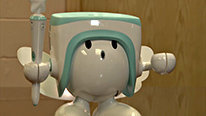NSF Awards: 1114515
Capitalizing on the power of story to teach foundational computational thinking (CT) concepts, WGBH and the Educational Development Center have undertaken research to answer the question: Can parent/child engagement with digital media and hands-on activities improve children’s early learning of computational thinking? The project team utilized an iterative research and design process with children and their parents to create media (animated and live-action video narratives) and hand-on activities (joint media engagement activities), while investigating how learning can be enriched and deepened through successive interactions. Following the creation of these resources, a experimental impact study is now being conducted using a mixed-methods approach to capture evidence on the extent to which these resources encourage the development of young children’s CT, as well as assessing parents’ comfort and interest in the subject.
Concurrent with this design-based research process, the project is working with the BUILD initiative to build on the infrastructure of state systems of early education and care and public broadcasters of two target states—Mississippi and Maryland—to develop a comprehensive workshop kit and a parent engagement toolkit, a 6-week program designed for parents to become fluid with integrating CT activities seamlessly throughout their children’s daily routines.









Gerad OShea
Research Director
Thanks for sharing your work!
Can you share any additional details or best-practices that have emerged for using media and state partners to reach and encourage parents to lead these activities with their children?
Marisa Wolsky
Executive Producer
Hi Gerald,
Thanks for your interest in our project. Our work with state partners is in process, but here are recommendations and best-practices with regard to joint-media engagement with parents and children.
Let me know if you have any questions and further thoughts for discussion. Thanks! Marisa Wolsky
Nancy McGowan
Instructional Math Coach
You KNOW your audience. :) The language is kid friendly and the video shows that children have time to explore, identify, and make sense of the situation. The sample program was very engaging and the one on one activities for children and parents are so easy to accomplish. Love your work! Is Aha Island available to try?
Marisa Wolsky
Executive Producer
Hi Nancy,
We are still in the development stage on the materials but will be disseminating the project nationally in the future. The timing right now is TBD. Thank you very much for the compliment and we can let you know when it is available if you send your contact info our way. Best, Marisa Wolsky
Jena Barchas-Lichtenstein
This is such a neat project!
How did you recruit caregivers and children to test out the materials? I'm also curious to hear more about the kind of training and support that's available for the caregivers. Is their comfort and familiarity with the concepts also growing through the project?
Marisa Wolsky
Executive Producer
Thank you! Caregivers and children were recruited from early childhood education centers in the Northeast, US. Because EDC researchers found it challenging to recruit families in earlier phases of the research, they made significant changes to their recruitment process, including starting earlier, casting a wider net, and incentivizing centers to help recruit families. As a result, EDC was able to enroll 151 families in the study, representing a significant over-enrollment beyond our initial goal of 120 families.
Prior to testing out the materials, caregivers were not given training, but they did participate in an initial orientation session, during which they completed a pre-survey, oriented themselves to their tablet, and received a schedule of media and activities to explore with their child over the next 6 weeks. The materials caregivers were given, though, did give them an overview of CT and emphasized activities that incorporate CT into everyday family activities like setting the table. EDC researchers are in the process of analyzing the data from this impact study, including comparing caregivers' responses pre- and post- the intervention. When they are done, we will be able to assess whether caregivers' comfort and familiarity with the concepts grew.
Thanks for your interest in our project! Marisa Wolsky
Feng Liu
Researcher
Thanks for sharing this very interesting work! I agree with the theory integrated in this project that is student early exposure to computational thinking (CT) or any other concepts could affect their later interest and pursue further knowledge in those areas. I would like to know more about the experimental impact study you are currently undertaking. Could you share more information on the study design approach (e.g., randomized control trail) and instrument to measure the outcome of interest (assuming is children’s computational thinking skills)?
Heather Lavigne
Research Scientist
Hi Feng! Thanks so much for your comments! In our final phase of project work, we’re looking for preliminary evidence of effectiveness for the videos and hands-on activities that were designed to support at-home joint engagement around CT. The research team has assigned participating families to one of two groups (CT intervention group, control group with non-CT media and activities). Families will use the at-home materials over a period of 6-weeks. The data we are gathering include pre/post data from participating parents and caregiver interview data following the intervention period. A sub-sample of children will be selected to participate in a set of post-intervention learning and transfer tasks to examine children’s use of CT strategies for solving problems and accomplishing goals. The exploratory transfer task is designed to investigate the extent to which children in the CT intervention group transfer the CT strategies modeled in non-programming contexts to a task that asks them to program a pathway for a robot. - Heather
Feng Liu
Researcher
Thanks for the detailed explanation about the study design and outcome measures, Heather!
Further posting is closed as the showcase has ended.